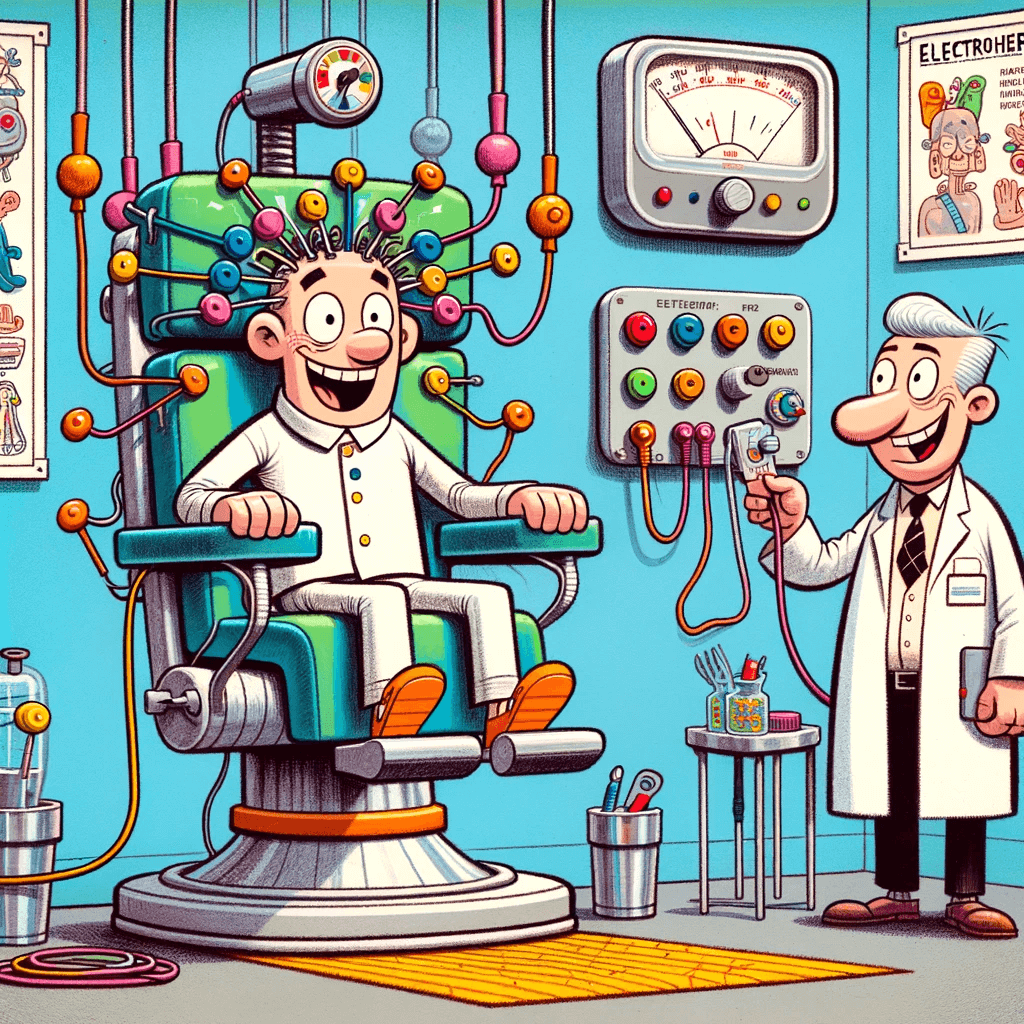Electrotherapy, a realm where science fiction meets reality, is like having a party with electricity, but nobody gets shocked – unless they want to. It’s not just about strapping some pads on and hoping for the best; there’s an art to tickling muscles and nerves with just the right amount of zap. Dive into the electrifying world of electrotherapy, where every jolt is a step towards feeling better, or at least more interesting.
Electric Eels in Physical Therapy? Fact or Fiction!
Ever heard the one about electric eels in physical therapy? It’s the kind of tale that makes you want to wiggle like you just stepped on a Lego barefoot. Picture it: you’re chilling at the spa, and instead of a hot stone massage, they bring out an eel. “Don’t worry, it’s just a little zap,” they say. Right, and I’m the Queen of England.
Now, let’s get real. Using electric eels for muscle stimulation is like trying to use lightning to charge your phone – ambitious but not exactly a bright idea. Besides, can you imagine the waiver form for that? “Please sign here to acknowledge potential eel bites and accidental superpowers.”
Speaking of superpowers, did you know some folks actually thought these slithery shockers could cure everything from back pain to a bad mood? Imagine going in for a bit of muscle recovery and coming out with the ability to power a small city. “Hey, Bob, how was physical therapy?” “Great, I can jump-start cars with my fingertips now.”
But let’s face it, in the world of alternative pain relief, electric eels are more of a comic book scenario than a clinical electrotherapy technique. It’s like opting for a bear hug when you just need a pat on the back – overly intense and slightly terrifying.
To sum it up, electric eels in physical therapy remain firmly in the category of ‘fun to think about, not so fun to try.’ It’s a good laugh, but I’ll stick to my Transcutaneous Electrical Nerve Stimulation (TENS) machine, thank you very much. And as for our slippery, shocky friends – let’s leave them to make waves in the ocean, not in the therapy room.
Thomas Edison’s Secret Electrotherapy Disco Parties
Imagine Thomas Edison, not just as the light bulb guy but as the undisputed king of disco. There are whispers that he threw the most electrifying parties, not just illuminated by his famous bulbs but powered by his secret weapon: electrotherapy. Envision him decked out in a 70s disco outfit, using electrical muscle stimulation (EMS) to get his inventor’s joints grooving.
The dance floor would be a remarkable scene! Historical figures getting down, thanks to a bit of Transcutaneous Electrical Nerve Stimulation (TENS). Ben Franklin, known for his kite and key, would be there doing the electric slide, energized by Interferential therapy. This is muscle strength enhancement at its most rhythmic.
And the side effects? Besides being the heart and soul of the party, these electrified guests might have found unexpected relief from their chronic pain and sciatica. Forget inventing the cotton gin; Eli Whitney could be seen inventing new dance moves, all thanks to a little Neuromuscular electrical stimulation (NMES).
Edison’s shindigs were more than mere entertainment; they were a dazzling display of electrotherapy’s potential. From rehabilitation jigs to nerve damage therapy boogies, each twist and turn was a celebration of electricity’s role in physical therapy.
So, the next time you turn on a light, spare a thought for Edison. Not only did he brighten our homes, but he might have also sparked the world’s first electric boogie. These tales might be more fiction than fact, but isn’t it fun to believe in a world where disco and electrotherapy merged to create the ultimate dance therapy extravaganza?
Can Electrotherapy Give You Superpowers? A Deep Dive
Ever wondered if zapping yourself with electrotherapy could turn you into Spider-Man? I mean, who hasn’t dreamt of shooting webs and scaling walls after a session of electrical muscle stimulation (EMS)? If comic books were a guide, we’d all be signing up for Transcutaneous Electrical Nerve Stimulation (TENS) instead of gym memberships.
Now, imagine walking into physical therapy and walking out with the ability to fly. “Oh, you’re here for back pain relief? How about we throw in some super strength as a bonus?” That’s one way to enhance muscle strength, or at least lift your spirits.
But let’s get real for a second. While electrotherapy is fantastic for pain management and rehabilitation, the closest it’ll get you to being a superhero is maybe feeling a little less like the Tin Man in the morning. Sure, Neuromuscular electrical stimulation (NMES) might make your muscles feel invincible but don’t start picking fights with supervillains just yet.
In the world of electrotherapy for athletes, it’s all about recovery and performance enhancement, not leaping tall buildings in a single bound. Think more along the lines of faster muscle recovery, less about faster-than-a-speeding-bullet.
And as for side effects, sadly, gaining the power to control electricity isn’t one of them. The most you’ll get is relief from sciatica, not sci-fi-level powers. So, if you’re using electrotherapy for nerve damage therapy, don’t expect to start shooting lightning from your fingertips.
Aliens Invented Electrotherapy – The Untold Conspiracy
Have you ever considered that aliens might be behind electrotherapy? Yeah, those shiny, high-tech electrotherapy devices aren’t just for physical therapy; they’re intergalactic communication gadgets. It’s like E.T. phoning home, but instead of a phone, he’s using Transcutaneous Electrical Nerve Stimulation (TENS).
Think about it. Why else would electrotherapy be so effective at muscle stimulation and pain management? Clearly, aliens, with their advanced technology, have gifted us with the secrets of electrical muscle stimulation (EMS) and Neuromuscular electrical stimulation (NMES). It’s not just about rehabilitating your back pain; it’s about preparing humanity for cosmic conversations.
And let’s not forget the side effects of electrotherapy, like feeling strangely uplifted after a session. Maybe it’s not just the muscle recovery talking. Maybe it’s a subtle way of aliens boosting our mood for better interstellar relations. After all, who wouldn’t want to be chirpy when chatting with extraterrestrial beings?
The history of electrotherapy suddenly makes more sense when you toss aliens into the mix. Those ancient tales of medical electricity? Clearly, early alien visitors sharing their healing techniques. And now, we’re using those very methods for everything from treating arthritis to managing depression and anxiety.
But wait, there’s more. Functional electrical stimulation (FES) and Interferential therapy might just be the alien way of saying, “Hello, Earthlings! Ready for some galactic gossip?” Next time you strap on an electrotherapy device, remember you might be unwittingly sending signals to a galaxy far, far away.
So the next time someone dismisses electrotherapy as just another physical therapy tool, give them a wink and say, “Or maybe it’s our ticket to joining the intergalactic community.” Who knows, maybe aliens are tuning in, nodding approvingly at our use of their sophisticated technology. Welcome to the universe of medical electricity – alien style!
Electrotherapy as a Time Machine: H.G. Wells’ Lost Chapter
Ever thought about strapping on an electrotherapy device and zipping back to the Renaissance? Yeah, because nothing says “time travel” like a good jolt from a Transcutaneous Electrical Nerve Stimulation (TENS) unit. Picture Leonardo da Vinci getting a buzz from electrical muscle stimulation (EMS) and suddenly inventing the iPad.
Imagine if Julius Caesar had access to Neuromuscular electrical stimulation (NMES). One minute, he’s getting treated for back pain; the next, he’s skipping ahead to binge-watch “Rome” on Netflix. “Et tu, Brute? Wait, let me pause this.”
Now, let’s be clear, using electrotherapy for time travel is as likely as finding calorie-free pizza that tastes good. But, just for kicks, think of the historical figures who could’ve really used some modern pain management. Napoleon with an electrotherapy device for his sciatica? He might have been a bit taller in the history books.
And what about those Electrotherapy side effects? Instead of a little muscle recovery, you accidentally end up in the Jurassic period. “I just wanted some relief from my tennis elbow, and now there’s a T-Rex chasing me!”
The idea of using electrotherapy as a time machine might be as far-fetched as a penguin flying business class. But it’s fun to imagine Cleopatra using Interferential therapy and winding up at a spa in 2024. “Excuse me, where’s the pyramid? And what’s this ‘Wi-Fi’ everyone keeps talking about?”
In the grand scheme of things, electrotherapy’s real magic lies in its benefits for rehabilitation, athletic recovery, and chronic pain treatment. It’s not about meeting Shakespeare; it’s about meeting your own health goals. And who knows? Maybe one day, in the far future, someone will figure out how to make time travel happen. But until then, let’s keep our electrotherapy devices firmly in the present, where they belong.
Conclusion
Electrotherapy intertwines science with the extraordinary, leading to a unique exploration of its potential beyond conventional therapy. These imaginative forays, while playful, highlight the extensive capabilities and applications of this technology in modern healthcare. As a tool, electrotherapy not only offers therapeutic benefits but also invites us to consider the broader, more imaginative possibilities of medical electricity.
I'm a human being. Usually hungry. I don't have lice.
Recent Posts
Have you ever wondered what a day in the life of a professional tuba player looks like? Is it all glamour, glory, and groupies? Or is it a never-ending cycle of spit valves, slide grease, and the...
So, you've decided to dive into the wild world of eBay selling. Congrats! You're about to embark on a journey filled with excitement, adventure, and more than a few questionable purchases. But fear...

